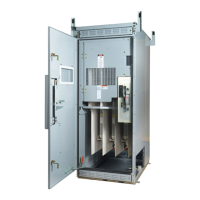22
Instructional Booklet IB02102006E
Effective May 2011
Type MVS (previously WLI)
metal-enclosed switchgear—
4.76 kV, 15.0 kV, 27.0 kV, and 38.0 kV
EATON CORPORATION www.eaton.com
Insulated bus maintenance
Insulated bus material is made from NORYL, a high-performance
engineering thermoplastic.
WARNING
USE OF SOLVENTS, OILS, JOINT COMPOUNDS, OR GREASES ON OR NEAR
NORyL INSULATION WILL DESTROy IT.
CLEAN ONLy WITH WATER OR ISOPROPyL ALCOHOL.
CAUTION
ISOPROPyL ALCOHOL IS FLAMMABLE. PROVIDE ADEQUATE VENTILATION
AND KEEP AWAy FROM FLAMES AND OTHER IGNITION SOURCES.
CONSULT yOUR SAFETy DEPARTMENT BEFORE USING.
NORYL can be irreversibly damaged if it comes in contact with
certain petrochemicals. Such petroleum-containing products as
solvents, oils, greases, and electrical joint compounds are especially
harmful. Materials not specifically approved by Eaton should not
come in contact with the NORYL. Only specified tapes and fillers
should be used when insulating busbar joints (see page 11).
Bus insulation cleaning procedure
The intent of the cleaning procedure is to remove as much dirt,
dust, and other foreign material as possible from the insulation
with minimum exposure to any solvents. The recommended
cleaning procedure is to use a lint-free cloth. In most cases,
this will be sufficient.
For accumulations that cannot be removed by the above procedure,
a lint-free cloth slightly dampened with water or isopropyl alcohol
can be used. Allow the apparatus to air dry for at least 4 hours
at room temperature before energizing.
CAUTION
HAzARD OF ELECTRICAL SHOCK OR BURN. USING ELECTRICAL JOINT
COMPOUNDS CONTAINING PETROLEUM HyDROCARBONS WILL DESTROy
NORyL INSULATION. THIS MAy RESULT IN DIELECTRIC FAILURES THAT IN
TURN WILL RESULT IN BODILy INJURy OR DEATH.
DO NOT USE SOLVENTS, OILS, OR GREASES ON OR NEAR THIS MATERIAL.
DISTILLED WATER AND ISOPROPyL ALCOHOL ARE THE ONLy APPROVED
CLEANERS FOR THIS INSULATION.
In general, the switch requires only moderate lubrication. All excess
lubrication must be removed with a clean cloth to prevent any
accumulation of dust or dirt. Avoid getting any lubrication on
the insulation.
Conductive grease (Eaton part number 7274A48H02) should be
applied sparingly to contact surfaces on the break jaw and between
the blade and hinge.
Eaton grease 53701AI should be applied to the spring rod(s) at the
stationary end pivots.
If the handle casting and/or the spring lever is dragging the switch
contacts open or closed, when the switch is opened or closed, one
of the following methods must be used to correct this problem.
Preferred lubrication method
Step 1: Remove the shaft (see “Shaft or bearing replacement”
section on page 21).
Step 2: Disassemble the rotating components on the shaft. This may
require wetting with a spray lubricant or mineral spirits to soften it
before the parts can be removed.
Step 3: Clean the machined ends of the shaft and the rotating parts
that fit on the shaft.
Step 4: Re-lubricate all rotating parts.
Step 5: Reassemble the shaft.
Step 6: Reinstall the shaft (see “Shaft or bearing replacement”
section on page 21).
Alternate lubrication method
Step 1: Wet the rotating parts on the shaft and the ends of the shaft
with a spray lubricant and let it set for 15 minutes.
Step 2: Begin to work the rotating parts on the shaft back and forth
about 45 degrees of travel while holding the shaft in position with a
handle in the maintenance hub. If the parts are very stiff or “frozen,”
it may be necessary to repeat this several times before the spray
lubricant softens the hardened lubricant to allow the parts to
rotate freely.
Step 3: Once the parts are free, add a few drops of synthetic
lubricating oil and let it wick into the mating surfaces.
Step 4: Wipe off any excess oil.
ote:N Using this alternative lubrication method will require more attention
to periodic maintenance to ensure that the mechanism works correctly. The
mechanism should be re-oiled with synthetic lubricating oil at regular
intervals, making sure the any excess oil is wiped off.

